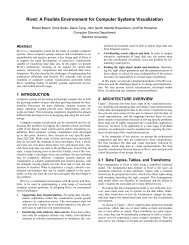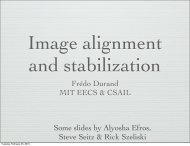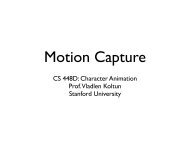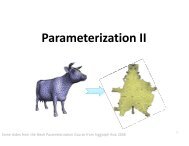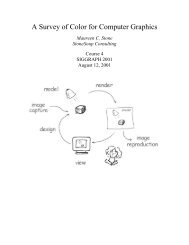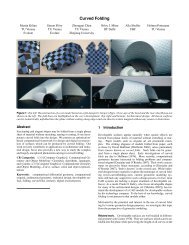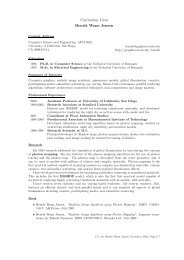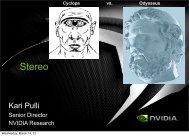A Physically-Based Night Sky Model - Computer Graphics Laboratory
A Physically-Based Night Sky Model - Computer Graphics Laboratory
A Physically-Based Night Sky Model - Computer Graphics Laboratory
Create successful ePaper yourself
Turn your PDF publications into a flip-book with our unique Google optimized e-Paper software.
The structure of the interplanetary dust is not well-understood.<br />
To to simulate zodiacal light we use a table with measured values<br />
[38]. Whenever a ray exits the atmosphere, we convert the direction<br />
of the ray to ecliptic polar coordinates and perform a bilinear<br />
lookup in the table. This works well since zodiacal light changes<br />
slowly with direction and has very little seasonal variation. A result<br />
of our zodiacal light model is illustrated Figure 8.<br />
6.2 Airglow<br />
Airglow is faint light that is continuously emitted by the entire upper<br />
atmosphere with a main concentration at an elevation of approximately<br />
110 km. The upper atmosphere of the Earth is continually<br />
being bombarded by high energy particles, mainly from<br />
the Sun. These particles ionize atoms and molecules or dissociate<br />
molecules and in turn cause them to emit light in particular spectral<br />
lines (at discrete wavelengths). As the emissions come primarily<br />
from Na and O atoms as well as molecular nitrogen and oxygen the<br />
emission lines are easily recognizable. The majority of the airglow<br />
emissions occur at 557.7nm (O-I), 630nm (O-I) and a 589.0nm -<br />
589.6nm doublet (Na-I). Airglow is the principal source of light in<br />
the night sky on moonless nights.<br />
Airglow is integrated into the simulation by adding an active<br />
layer to the atmosphere (altitude 80km) that contributes a spectral<br />
−8 W<br />
in-scattered radiance (5.1·10 m2 , 3 peaks, at 557.7nm, 583.0nm<br />
and 630.0nm).<br />
6.3 Diffuse Galactic Light and Cosmic Light<br />
Diffuse galactic light and cosmic light are the last components of<br />
the night sky that we include in our model. These are very faint<br />
−8 W<br />
(see Figure 2) and modeled as a constant term (1 · 10 m2 ) that is<br />
added when a ray exits the atmosphere.<br />
6.4 Atmosphere <strong>Model</strong>ing<br />
Molecules and aerosols (dust, water drops and other similar-sized<br />
particles) are the two main constituents of the atmosphere that affect<br />
light. As light travels through the atmosphere it can be scattered<br />
by molecules (Rayleigh scattering) or by aerosols (Mie scattering).<br />
The probability that a scattering event occurs is proportional to the<br />
local density of molecules and aerosols and the optical path length<br />
of the light. The two types of scattering are very different: Rayleigh<br />
scattering is strongly dependent on the wavelength of the light and<br />
it scatters almost diffusely; aerosol scattering is mostly independent<br />
of the wavelength, but with a strong peak in the forward direction<br />
of the scattered light.<br />
We model the atmosphere using a spherical model similar to that<br />
of Nishita et al. [29, 31] and use the same phase functions to approximate<br />
the scattering of light. To simulate light transport with<br />
multiple scattering, we use distribution ray tracing combined with<br />
ray marching. A ray traversing the atmosphere uses ray marching to<br />
integrate the optical depth, and it samples the in-scattered indirect<br />
radiance at random positions in addition to the direct illumination.<br />
Each ray also keeps track of the visibility of the background, and all<br />
rays emanating from the camera save this information in the alpha<br />
image (as discussed in Section 5.1). This method is fairly efficient<br />
because the atmosphere is optically thin. Also, the method is very<br />
flexible and allows us to integrate other components in the atmosphere<br />
such as clouds and airglow.<br />
We model clouds procedurally using an approach similar to the<br />
one described in [9]. Clouds are similar to the atmosphere, but<br />
as they have a higher density, the number of scattering events<br />
will be larger. For clouds we use the Henyey-Greenstein phasefunction<br />
[13] with strong forward scattering.<br />
To appear in the SIGGRAPH conference proceedings<br />
6<br />
7 Implementation and Results<br />
We implemented our night sky model in a Monte Carlo ray tracer<br />
with support for spectral sampling. We used an accurate spectral<br />
sampling with 40 evenly-spaced samples from 340nm to 740nm to<br />
allow for precise conversion to XYZV color space for tone mapping,<br />
as well as for accurately handling the wavelength dependent<br />
Rayleigh scattering of the sky. Simpler models could be used as<br />
well, at the expense of accuracy.<br />
Because our scenes are at scotopic viewing levels (rod vision),<br />
special care must be taken with tone mapping. We found the<br />
histogram-adjustment method proposed by Ward et al. [22] to work<br />
best for the very high dynamic range night images. This method<br />
“discounts” the empty portions of the histogram of luminance, and<br />
simulates both cone (daylight) and rod (night) vision as well as loss<br />
of acuity. Another very important component of our tone-mapping<br />
model is the blue-shift (the subjective impression that night scenes<br />
exhibit a bluish tint). This phenomena is supported by psychophysical<br />
data [15] and a number of techniques can be used to simulate<br />
it [8, 17, 43]. We use the technique for XYZV images as described<br />
in [17].<br />
Many features of our model have been demonstrated through the<br />
paper. Not all of the elements can be seen simultaneously in one<br />
image. In particular, the dimmest phenomena such as zodiacal light<br />
are visible only for moonless nights. Phenomena such as airglow<br />
and intergalactic light are present only as faint background illumination.<br />
Nonetheless, all these components are important to give a<br />
realistic impression of the night sky. The sky is never completely<br />
black.<br />
Our experimental results are shown in the two color pages at the<br />
end of the paper. The captions explain the individual images. All<br />
the images were rendered on a dual PIII-800 PC, and the rendering<br />
time for most of the individual images ranged from 30 seconds to<br />
2 minutes. It may seem surprising that multiple scattering in the<br />
atmosphere can be computed this quickly. The main reason for this<br />
is that multiple scattering often does not contribute much and as<br />
such can be computed with low accuracy — as also demonstrated<br />
in [29]. The only images that were more costly to render are the<br />
images with clouds; we use path tracing of the cloud media and this<br />
is quite expensive. As an example the image of Little Matterhorn<br />
[35] with clouds (Figure 13) took 2 hours to render.<br />
A very important aspect of our images is the sense of night. This<br />
is quite difficult to achieve, and it requires carefully ensuring correct<br />
physical values and using a perceptually based tone-mapping<br />
algorithm. This is why we have stressed the use of accurate radiometric<br />
values in this paper. For a daylight simulation it is less<br />
noticeable if the sky intensity is wrong by a factor two, but in the<br />
night sky all of the components have to work together to form an<br />
impression of night.<br />
8 Conclusions and Future Work<br />
This paper has presented a physically-based model of the night sky.<br />
The model uses astronomical data and it includes all the significant<br />
sources of natural light in the night sky. We simulate the direct appearance<br />
of the Moon, stars, the Milky Way, the zodiacal light, and<br />
other elements. In addition we model the illumination from these<br />
sources of light including scattering in the atmosphere. Finally, we<br />
use accurate spectral sampling and tone-mapping in order to render<br />
convincing images of night scenes.<br />
Our model suggests several interesting areas for future work.<br />
Additional optical effects that we would like to include involve<br />
the modeling of small discrepancies, such as the hiding effect that<br />
causes the Full Moon to be brighter than expected, the luminescence<br />
of the Moon due to ionization caused by solar particles, and<br />
the seasonal and diurnal variations of airglow. More work remains




